Beneath Vatican City
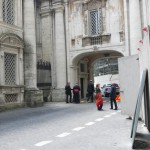 The religious and historical importance of the Vatican excavations–the “Necropolis under St. Peter’s Basilica”–will bring you to your knees. In the 1960’s the Vatican announced with certainty that the tomb of Pete had been found–hidden away for two thousand centuries in a place directly under the present High Altar in the Basilica today! But this is no coincidence. The excavations we saw beneath the Vatican in the SCAVI tour were amazing. Here’s how the day went, and here’s why the Vatican is certain that the grave is that of the Apostle Peter.
The religious and historical importance of the Vatican excavations–the “Necropolis under St. Peter’s Basilica”–will bring you to your knees. In the 1960’s the Vatican announced with certainty that the tomb of Pete had been found–hidden away for two thousand centuries in a place directly under the present High Altar in the Basilica today! But this is no coincidence. The excavations we saw beneath the Vatican in the SCAVI tour were amazing. Here’s how the day went, and here’s why the Vatican is certain that the grave is that of the Apostle Peter.
Jimmy and I were told to enter at the Holy Gate behind the colonnade to the left of the Basilica. We got there early so as not to miss a thing. There were lots of rules–ladies to wear long skirts or pants, no bare shoulders, no open toed shoes and no pictures during the tour. 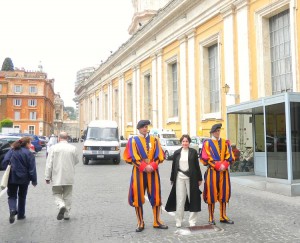 The Swiss guards were friendly but absolutely refused to let us in until ten minutes before the scheduled time. I tried to talk them into an exception, but they paid absolutely no attention to my pleas and didn’t miss a beat. So we found a lovely sidewalk cafe on a side-street nearby and waited.
The Swiss guards were friendly but absolutely refused to let us in until ten minutes before the scheduled time. I tried to talk them into an exception, but they paid absolutely no attention to my pleas and didn’t miss a beat. So we found a lovely sidewalk cafe on a side-street nearby and waited. 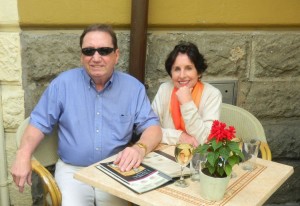
The tour was small–a guide and seven others. Here are some pictures of this part of the Vatican behind the walls, the Basilica, and the Vatican Museum. I was surprised to learn that this very spot is actually the real location of the original ‘Circus Maximus’ where the Emperor Nero slaughtered Christians after Rome burned. Hoping to deflect attention from his own careless rule, Christians became his scapegoats for the great fire. He dressed his victims in animal skins fed them to tigers; he used them as human candles at celebrations, driving his chariot through them. It wasn’t until some years later that the Circus was moved to the location behind the Paletine Hill, near the Forum that we see today.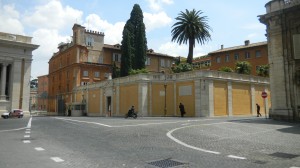
We walked through narrow, winding passages for about half-an hour first through a burial room with rows of beautifully carved marble sarcophagus of Popes back to the third century, then on through an ancient Roman cemetary and a series of mausoleums, some pagan, some Christian. Christian tombs were not marked with a cross, as that would invite persecution. Instead they were marked with other symbols, such as a palm leaf.
The discovery of Peter’s grave occurred in the late 1950’s and early 1960’s. In the first century the Vatican grounds and the location of Peter’s crucifixion and grave were outside the city walls of Rome. The Apostle’s grave was marked with reverence from the beginning, and in the second century a monument known today as the “Trophy of Gaius” was erected over the grave. The monument, or trophy, was simple and left unmarked so that only Christians would know the significance. The word ‘trophy’ was used by the Romans during those times as a symbol of victory. Christians used the Roman model for their monument, but as a symbol of the victory over death through Christ’s and faith. But the key to the secret lay in a red plaster wall found beside the grave. Almost every inch of this wall was covered with early Christian graffiti mentioning Peter.
As we walked toward Peter’s crypt we could see the facade of the foundations of the first church built over the grave by the Emperor Constantine in the third century. We were walking up the slant of a hill, nearer to the ground as centuries passed. The older brick walls eventually gave way to the fifteenth century walls of the Basilica still standing today.
Our guide told us that in the third century during the reign of the Emperor Constantine, the bones of the Apostle were removed from the grave to preserve them. They were placed in a small niche in the red wall mentioned above. Archeologists have now dated the red wall to the middle of the second century through tile stamps. The second century Roman scholar, Gaius , wrote about the trophy monument, stating that it marked the grave of Peter. His words were preserved by the early Church father, Eusebius of Caesarea.
The bones of Peter were preserved through the centuries in that dry place in the red wall, wrapped in a purple cloth interwoven with gold thread. Purple was a color reserved in those days for royalty,a sign of the emperor’s reverence for the apostle. Constantine built a marble shrine in the shape of a large box around the grave and bones and the red wall. When the purple cloth was opened during the excavations, the only bones missing were those of the feet, verifying the belief that Peter was crucified upside down and his feet were cut off to remove him from the cross. Some of the bones have been placed in the Pope’s private chapel. The remainder are still underground in Constantine’s marble shrine.
To see the crypt and bones you enter a grotto –the Clementine Chapel, comissioned in the fifteenth century. The small arched golden chapel is simply a work of art as beautiful as any seen in the Vatican Museum. It’s laid out in the shape of an upside down cross.
Through a bronze door on the side of the chapel we came to another room, and there, through a small opening covered with glass, we peered down into the crypt. Here, also, was the Red Wall–the graffiti wall–with its multitude of Christian inscriptions in the plaster. We saw a piece in which was scratched the words: ” Here is Peter.” Pieces of some of the bones of the Apostle Peter were set on small cushions behind the glass. They were well lit, each several inches long. They looked like ivory in the earie underground light.
These were the bones of the first apostle. It took a moment for the fact to sink in and this was emotional for everyone on the tour. It was difficult to comprehend that we were in the presence of these treasures of religion and history. Imagine — Peter’s grave was revered after his death in the first century, then marked with the trophy in the second. A church was built over it in the third century by Constantine. In the fifteenth century the Bascilica we have today was built, and all of this has only just been discovered. No one said a word. In the silence, we closed our eyes and prayed. Faith does not depend on precious relics like these bones, or the Shroud. But these are gifts perserved for us through thousands of years and for that reason they are sacred to me. I thought of the words of Jesus in the Gospels – You are Peter, and on this rock I will build my church.
Whew! What an amazing trip this has been, to see the Shroud, and then the crypt, the Red Wall, and the bones of Peter. Well, I will write more on this later. Tommianne Guy left a comment on an earlier blog, asking–to paraphrase–what I think the impact of the Shroud would be on the world if everyone believed that it was real. That’s one to ponder before I give my own opinion, but I will give that a try very soon, so stay tuned! And you’ll find all the latest research, and some not found in the mainstream media in my novel, Secret of the Shroud, coming in September! ![SecretoftheShroud[1].lr (2)](http://www.pamelaewen.com/wp-content/uploads/2010/05/SecretoftheShroud1.lr-22-194x300.jpg)
Before leaving Rome, Jimmy and I had dinner at Alfredo’s, home of the original dish–Fettucini Alfredo! This fettucine, laced with everything good, just melts in your mouth. Here’s a picture of that riotous night–great music, singing, and the best food in the city! The group singing is a choir from Kansas, in Rome to sing at the Catacombs and churches. (If you go to Alfredo’s, be aware that there are two restaurants by that name. The one you want is beside the tomb of the Emperor Augustus, so don’t let anyone send you to the wrong one.) 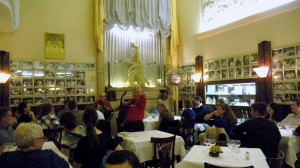
We’ll be traveling for twenty-four hours again to get home. I’m not looking forward to that. We connect to flights in New York and Houston before returning to New Orleans. Security in both Rome and New York were very tight coming over, which is comforting, but takes a lot of time. So…until we meet again!







“Tommianne Guy left a comment on an earlier blog, asking–to paraphrase–what I think the impact of the Shroud would be on the world if everyone believed that it was real.”
In my opinion, the impact would be no greater than currently exist. “You believe there is one God. Good! Even demons believe that —and shudder.” James 2:19, NIV. Giving people a reason to be at peace with God, who does not grant every whim of man nor satisfy human ideas of who he should be, would have the greater impact. Most people insist God loves them no matter how they choose to live. Will those same people love God no matter how he chooses to live?
Its such as you learn my mind! You seem to know a lot about this, like you wrote the e book in it or something.
I feel that you just can do with some % to power the
message home a little bit, but other than that, that is fantastic blog.
An excellent read. I’ll definitely be back.